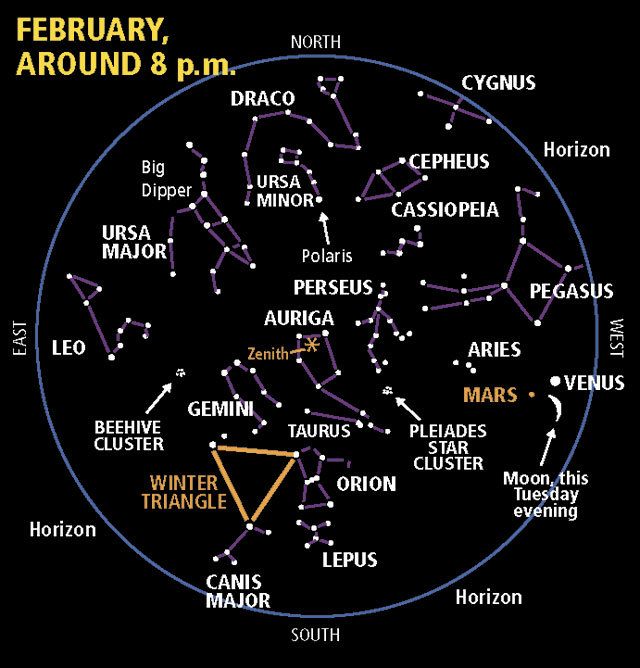Star-watching is wonderful this month. In fact, this is one of the best times of the year. It’s worth bundling up for, and then some.
To start out the stargazing adventure this month, check out the great conjunction, or what I call a “celestial hugging,” between the super-bright planet Venus and the red planet Mars. They’re nowhere near each other physically, but they’re getting really close to each other in the night sky in nearly the same line of sight. This week they’re only about 5 degrees away from each other, which is about half of your fist held at arm’s length.
As an added attraction, Venus and Mars will be joined by the crescent moon. The moon will be parked just to the left of the planetary pair.
Venus is about 47 million miles away and Mars is nearly 177 million miles away. Unfortunately neither one of them are a great telescope target because Mars is so far away from Earth right now and Venus has a very thick cloud cover. The really cool thing about checking out Venus, even with a small telescope, is that it goes through phases like our moon since its orbit around the sun lies within Earth’s orbit. Right now, Venus is crescent-shaped.
Even if you have to put up with urban lighting like I do, you can still see a lot of bright stars and constellations, especially in the southern half of the sky.
The constellation Orion the Hunter and the gang of bright constellations surrounding him are the main celestial event.
There’s Orion himself, surrounded by his cast of characters like Taurus the Bull; Auriga, the retired chariot driver turned goat farmer; Gemini the Twins; Lepus the Killer Rabbit; Canis Minor, the Little Dog; and Canis Major, the Big Dog. At the nose of the Big Dog is Sirius, the brightest star we see in the entire night sky anytime of the year, shining brightly more than 50 trillion miles, or about 8.5 light-years, away.
You would think with the logjam of bright stars and constellations in the winter sky that we would be facing toward the center of our Milky Way Galaxy. Actually, though, we’re facing away from the galactic center and looking toward the edge of our galaxy. In that direction, however, there happens to be one of the brighter arms of our Milky Way. The nighttime side of the Earth faces the Milky Way’s center in the summertime. Without a doubt the stars of summer, especially late summer, are wonderful, but nowhere near as dazzling as the winter constellations.
A wonderful telescope target this month is right in the midst of Orion and his Gang. It’s the Orion Nebula in the sword of the constellation Orion the Hunter. It’s a huge cloud of hydrogen gas, more than 30 light-years in diameter. That’s almost 180 trillion miles in girth. You will love what you see. The nebula will have a slight greenish tinge to it, and even in the smallest of telescopes you’ll see four stars that are arranged in a lopsided trapezoid. Those stars and many others that you can’t see were all born out of the Orion Nebula. One of the stars in the trapezoid may only be 50,000 years old, which is extremely young for a star. The glow of the nebula is caused by the extreme ultraviolet radiation from the new stars causing the hydrogen gas to light up like a neon light. Astronomers call this kind of nebula an emission nebula. The Orion Nebula will produce many more stars in the future, maybe even another 10,000 stars the size of our sun.
Believe it or not, there are signs of spring in the February skies with the first early evening appearance of the constellation Leo the Lion. Leo resembles a backwards question mark in the eastern sky. You’ll get a lot better look at it later in the evening as it rises higher.
Talk to us
> Give us your news tips.
> Send us a letter to the editor.
> More Herald contact information.

























